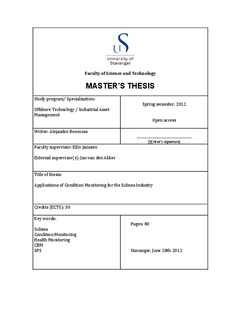| dc.description.abstract | With the increased interest in developing offshore fields by subsea completions, also comes the need for minimizing the non-productive time of these systems caused by unexpected failures and lengthy repairs. Maintenance interventions that could be considered simple for surface equipment can become expensive and complicated when executed under water due to the difficult accessibility of the equipment. A simple failure of a subsea component can cause shutdown of a well for several days or even weeks until a repair is carried out, thus affecting hydrocarbon production rates significantly.
Failure of components is unavoidable, but by introducing condition monitoring to subsea production systems (SPS), operators can diagnose and predict failures early, which allows them to plan maintenance activities in advance and reduce downtime. Most of today’s subsea control systems collect great amount of data about the process and the operational parameters of the equipment, but this information is not used to determine the condition of the asset and predict future failures. The aim of this thesis is to develop a methodology tailored for conventional SPS, for appropriate utilization of available monitoring techniques and identification of additional surveillance methods needed to guarantee high system availability. Furthermore, this methodology describes how to integrate these monitoring methods into a comprehensive condition monitoring program that is able to detect asset state, diagnose faults, predict future failures and provide decision support for maintenance intervention.
Considerable research and many standards have been written for condition monitoring of complex machinery, mostly for rotating machinery and some static machines for surface or onshore facilities, but little investigation has been done with respect to subsea equipment. The purpose of this research study is to bridge the gap by creating a set of guidelines for implementation of condition monitoring specifically for SPS, and make recommendations for application of these guidelines for the benefit of both field operators and subsea equipment manufacturers.
A methodic process was created to guide the user through the different steps of creating a program for condition monitoring of underwater equipment, with emphasis in the active elements used to measure and control the flow of oil and gas, i.e. control systems (SCM, instruments, sensors, valves, electrical/hydraulic flying leads, etc.) and production equipment (XTs, manifolds and distribution units). Risers, flowlines, umbilicals, structures and subsea processing systems are excluded from this work. The methodology is exemplified with two case studies: First for gate valves with hydraulic actuators and, second for the power supply unit located in the subsea electronic module. | no_NO |
